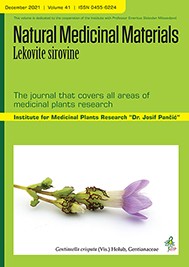Faculty of Biology, Institute of Botany and Botanical Garden “Jevremovac”, University of Belgrade , Belgrade , Serbia
Faculty of Biology, Institute of Botany and Botanical Garden “Jevremovac”, University of Belgrade , Belgrade , Serbia
Faculty of Biology, Institute of Botany and Botanical Garden “Jevremovac”, University of Belgrade , Belgrade , Serbia
Faculty of Biology, Institute of Botany and Botanical Garden “Jevremovac”, University of Belgrade , Belgrade , Serbia
Faculty of Biology, Institute of Botany and Botanical Garden “Jevremovac”, University of Belgrade , Belgrade , Serbia
Considering the increase of the elderly population in recent years, the growing prevalence of age-related neurodegenerative diseases (NDDs), including Alzheimer’s disease (AD) and Parkinson’s disease (PD), has become one of the leading healthcare problems. Currently, available therapies for AD and PD are still limited, while medicinal plants used in traditional medicine for millennia can inhibit enzymes involved in the neurodegeneration processes in AD (acetylcholinesterase, AChE, and butyrylcholinesterase, BChE) and PD (tyrosinase, TYR), hence their inhibiting effects are continuously being investigated especially in the past decade. This study was aimed to review data on medicinal plants as potential cholinesterases and TYR inhibitors reported from January 2018 until May 2021. The literature search was performed using several online bibliographical databases (Scopus, Web of Science, Science Direct, Google Scholar, PubMed, and ResearchGate) and two websites. Data analysis showed that the highest number of representatives belongs to Lamiaceae family (up to 20 %), followed by Asteraceae. Almost half of the tested samples were prepared from whole plant/aerial plant parts followed by leaves. The most frequently tested preparations were methanolic extracts (about 25 % of the samples examined). Additionally, synergistic interactions between different herbs and/or isolated compounds were considered as a promising strategy for further research. The presented data showed that medicinal plants preparations represent an unlimited source for research of new and more effective AD and PD treatments. This review will provide a useful starting point for further research on this topic.
This is an open access article distributed under the Creative Commons Attribution License which permits unrestricted use, distribution, and reproduction in any medium, provided the original work is properly cited.

The statements, opinions and data contained in the journal are solely those of the individual authors and contributors and not of the publisher and the editor(s). We stay neutral with regard to jurisdictional claims in published maps and institutional affiliations.